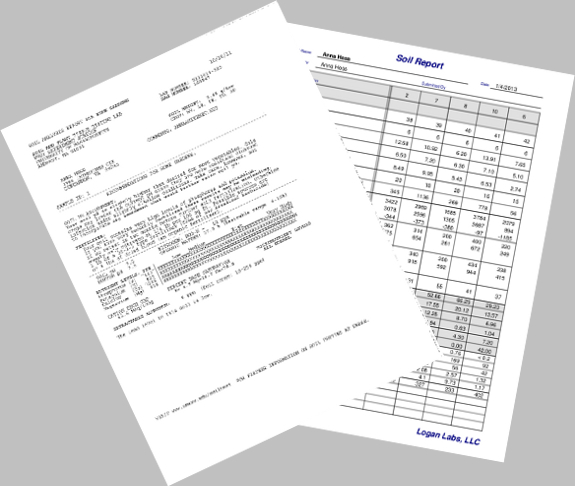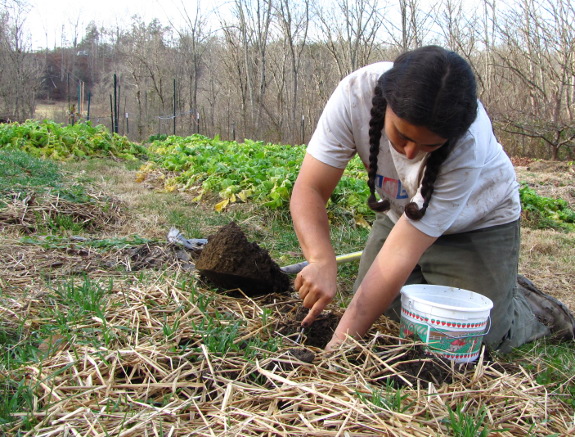
Different soil results from different labs

I got my soil
test results back,
and I'll be looking at them in much more depth than you probably want
to read about next week (and probably the week after) as a lunchtime
series. However, I thought it was interesting to see how
different test results can be from two different labs.

I doubt my soil has
changed very much over the last year, since I haven't added any major
amendments. And yet, this year's results show just about
everything much lower than last year's results showed, except for the
trace minerals, which are mostly higher.
(There are a couple of
mitigating factors to consider. I didn't take any samples from
the spots where I spread the gypsum. But I did take the
samples a little differently, testing deeper into the soil profile in
2012 because Solomon wanted a
six inch test depth for his analyses.)
| Mule 2011 | Mule 2012 | CP3 2011 | CP3 2012 | Back 2011 | Back 2012 | Front 2011 | Front 2012 | |
| pH | 7.55 | 6.9 | 6 | 5.9 | 7.3 | 7.1 | 7.4 | 7.3 |
| % OM | 17.7 | 4.87 | 8.2 | 5.48 | 15 | 7.82 | 14.6 | 8.95 |
| P (ppm) | 523 | 494 | 21 | 44.5 | 556 | 351.78 | 410 | 446.38 |
| K (ppm) | 774.5 | 404 | 351 | 306.5 | 615 | 298 | 875 | 487 |
| Ca (ppm) | 7555.5 | 2889 | 1643 | 1038 | 6801 | 1800.5 | 5772 | 2415 |
| Mg (ppm) | 989 | 441 | 213 | 175 | 926 | 299.5 | 743 | 421.5 |
| CEC | 70 | 20 | 15.6 | 9.88 | 56 | 12.9 | 47.1 | 17.63 |
| % Sat. Ca | 79 | 71 | 64.8 | 52.56 | 78.8 | 69.78 | 77.7 | 68.47 |
| % Sat. Mg | 16.95 | 18 | 13.8 | 14.77 | 17.6 | 19.35 | 16.4 | 19.92 |
| % Sat. K | 4.25 | 5 | 7.1 | 7.96 | 3.7 | 5.92 | 6.1 | 7.08 |
| Al | 6 | 215 | 14 | 402 | 6 | 220 | 7 | 247 |
| B | 1.5 | 0.67 | 0.5 | 0.29 | 1.3 | 0.56 | 1.1 | 0.62 |
| Mn | 22.2 | 41 | 4.5 | 30 | 24.4 | 43 | 19 | 47 |
| Zn | 8.05 | 43.57 | 12.5 | 6.64 | 7.5 | 17.07 | 8.5 | 38.34 |
| Cu | 1 | 3.19 | 0.9 | 2.03 | 1 | 2.8 | 1 | 3.46 |
| Fe | 2.15 | 248 | 2.2 | 153 | 2.1 | 215 | 1.7 | 236 |
| S | 126.5 | 24 | 33.8 | 19 | 109 | 20 | 100 | 19 |
Since these two labs
used different extraction techniques, it's not terribly surprising
their results varied. But you'd think there'd be one right answer
to how much sulfur (and everything else) there is in the soil. I
guess this is why Solomon recommends picking a lab and sticking to it
if you want to be able to tell the changes in your soil over time.
Want more in-depth information? Browse through our books.
Or explore more posts by date or by subject.
About us: Anna Hess and Mark Hamilton spent over a decade living self-sufficiently in the mountains of Virginia before moving north to start over from scratch in the foothills of Ohio. They've experimented with permaculture, no-till gardening, trailersteading, home-based microbusinesses and much more, writing about their adventures in both blogs and books.
Want to be notified when new comments are posted on this page? Click on the RSS button after you add a comment to subscribe to the comment feed, or simply check the box beside "email replies to me" while writing your comment.

Hi Anna,
You can find on the web several inter-lab tests where the 'same' soil was sent to a variety of labs. Even when the soil was well mixed, etc. the results are quite different.
You probably only want to compare the actual lab measurements between labs. This is made much harder in that percentages given are NOT what was measured.
I could go on and on. It's a real problem without an easy answer.
And the micro-trace elements that really matter aren't usually measured at all.
John
A measurement value by itself is almost meaningless. At the very least the (standardized or otherwise published) method by which it was carried out should be mentioned.
If the methods used by the two labs are different it will be very hard to compare the numbers, unless you know both methods and have enough knowledge of chemistry to be able to estimate the effect of both.
Hi Anna,
I would have thought you would have collected some real comments by now.
A good book to start with is Mike Astra's "The Ideal Soil Handbook". In some minerals you need enough like Calcium. In other cases the ratio is important. Zn to Cu and a lesser known Zn to Cd. And enough boron. Boron should be about 1/1000 of Ca. But high boron often inhibits germination.
You should check levels of Se for your health. There are many minerals that plants don't care about, but are very necessary for animals and humans. A little sprinkle can make a HUGE difference.
As I said earlier, there is quite a variation among consultants to make matters even more confusing. Pay attention to what the vets say. They are in general MUCH better informed than most MDs about what works for animal health. Read and listen to what Joel Wallach, DVM, MD has to say as a pretty good introduction to what really matters.
I always enjoy what you have to write. NICE JOB :).
John